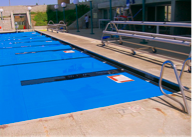Pool Covers = Major Savings...Guaranteed! If you can use them!!
Saturday, June 30, 2007
Last month we looked into the 6 largest energy (and money) savers of modern day pool operations. By far the Number One Energy Saver, according to the AFO course, is the use of a insulated pool cover system, which has traditionally saved users up to 66% of their annual heating costs.
You may have had experience in the past with residential-grade bubble covers and flimsy winder (or hand-deployment). This is a completely different animal !! In this follow-up article we will examine what they are, how they work, how much they can really save you, who can (and can’t) use them, and other pertinent options and details.
History:
Heat retention covers have been used in many municipal operations since the late 1970s, and CES has successfully installed and maintained millions of square feet of covers with well-documented results. While many companies sell these covers, only a handful MAKE them and few of those actually laminate the materials.
How they Work: Covers are comprised of insulated custom-fitted and trimmed, lightweight sections that float on the pool surface. They are stored on and deployed with multi-tubed stainless steel storage reels-winders. Figure 1 above shows how easily these covers can be to use.
How Pool Covers save money: Research has shown that 60% of heat loss in a swimming pool occurs out the TOP or surface through evaporation and convection, and an additional 30% occur out of the top through radiation. At the same time only 10% of loss occurs through the pool walls and piping. That means that over 90% of loss could be addressed by the use of a cover. A cover will reduce evaporation to near zero, and because it insulates, it also reduces conduction, convection, and radiant heat loss.
Quantifying Savings: Use of pool covers is a commitment that could save you 10’s of thousands of dollars a year and many times more over the lifetime of the cover. It is not, however, an investment that you want to jump into before reviewing the facts. How can you verify potential savings before investing?? Check References: Calling long-time cover users is a great way to receive verification of cover performance. Another way is to simulate savings using one of several methods including the Department of Energy (DOE) savings program called RESPEC. CES will gladly perform a RESPEC savings analysis on your pool in order to help you pinpoint potential savings. To take advantage of this offer, simply contact your CES Rep or fill out an RESPEC energy audit and fax back to CES. Due to seasonal backlogs, please allow up to 1-2 weeks for processing.
Another simple way to know that you are saving money is the “overnight test”. Simply put, an 85oF with a 50oF evening many times will lose 8-10oF in temperature overnight, depending on wind, etc. The gas heater (1-2 hours for each degree regained) or electric heat pump (3-4 hours for each degree regained) will work long and hard to recover that temperature. Customers with the similar situation AND a pool cover, have reported overnight losses of only 1-2oF, meaning that the run time is much less. Less run time means more savings.
Who should not use pool covers: While it is difficult to tell someone NOT to save thousands of dollars a year in energy costs, water, chemicals, etc., there are times when a cover SHOULD NOT be used. First of all, pools that are located directly on the ocean and are lacking proper wind breaks may have problems deploying the cover system during the windier winter months. Even though the covers are equipped with special time-tested wind edging, high winds can force their way under the cover and make it difficult to handle. The second example of a problem pool cover application is a larger free-form (amoeba-shaped) pool. Since covers are based on mostly rectangular-shaped sections with some allowance for curves, rounded corners, and smaller offsets....pools with little rectangular foundation will make for a more difficult manufacturing and more involved daily deployment. We have made covers for some wacky pools in the past, and they have saved lots of energy, but it takes a special condition and a special customer commitment.
Purchasing Pitfalls: One of the first pitfalls is ordering a pool cover from a catalog house. We have heard horror stories about customers getting mis-measured or otherwise defective covers, and trying to work out a resolution over the phone. Not a high percentage endeavor. We’ve also heard of covers with a 5-year warranty lasting 5 months before starting to unravel and tear. While pool covers may appear to be “all alike”, a closer look will show that there are many real differences that will make a huge impact in how well your cover will perform, and how long it will last.
Loose Specs = Loose fit: If your organization needs to go to bid to purchase a cover, then writing proper specs will be the difference between getting a decent (1-3 year) cover or a great (8-11 year) cover. Make sure that the cover-fit is the responsibility of someone other than yourself, and local warranty support and administration is a key. Also make sure that you post minimum standards for tensile strength, UV coating, tear strength, wind edging, and amount of square feet per winder reel. If you don’t, you may end up having to use an ill-fitting, soggy, and soon-to-be ragged cover every single day. Over the past 25 years as a pool cover provider, we have heard (and seen) enough horror stories to want us to err on the safe side....wouldn’t you?
While not every pool can utilize a pool cover, it is difficult to overlook the dynamic and verifiable results that they offer. DOE pool cover energy reports detail the potential savings, solid design means long-term savings, and CES on-site support means no-hassle satisfaction.
Please contact your CES rep for more information on our time-tested pool covers systems.



CES covers consist of many layers of laminated materials that have been proven to last over 10 years with proper care. No other cover manufacturer can make that claim. Many satisfied owners, and millions of sq. ft. installed since 1983.









Figure 1: A pool cover system is easy to use, you simply roll the winder to the first position, lock down the deck brake pads (to prevent unwanted winder movement), and roll out the first section by pulling the rope from across the pool. Next, the winder is moved to line up with section #2. That section is deployed the same as section #1. This process is repeated until the entire pool is covered with the custom-fitted covers. Special custom ladder cutouts and hinged sections allow for full coverage of a pool equipped with ladders, step entries, etc.
New XER cover carries extra support located in crucial stress points, and a 5-year warranty.
Special Cover protector provides a shield against UV-ray degradation during periods of non-use.